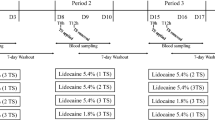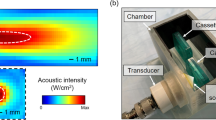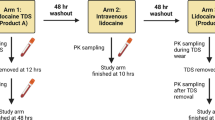Abstract
The purpose of the study was to determine whether lidocaine could be transported through living rat skin using alternating current and to determine whether lidocaine transport depends on voltage. The drug delivery cell was originally constructed for the application of an electric field. Hairless rats were anaesthetised using sevoflurane, and a tracheotomy was performed. The drug delivery cell, with lidocaine solution in the donor cell, was placed on the abdominal skin. Samples were collected from the subcutaneous tissue using a microdialysis probe inserted into the abdominal subcutaneous tissue, and the lidocaine concentrations in the samples were determined using high-performance liquid chromatography. The lidocaine concentration in the rat skin increased in time, and voltage-dependency was approximately linear. The lidocaine concentration after the application of 20 V for 21 min was about ten-fold higher than that observed after 21 min of passive diffusion. Lidocaine was successfully transported through living rat skin in a voltage- and time-dependent manner. This drug delivery cell may contribute to local anaesthesia and pain management of human skin.
Similar content being viewed by others
Explore related subjects
Discover the latest articles and news from researchers in related subjects, suggested using machine learning.References
Chien, Y. W., Lelawongs, P., Siddiqui, O., Sun, Y., andShi, W. M. (1990): ‘Facilitated transdermal delivery of therapeutic peptide and proteins by iontophoretic delivery devices’,J. Control Release,13, pp. 263–278
Cullander, C., andGuy, R. H. (1992): ‘Transdermal delivery of peptides and proteins’,Adv. Drug Deliv. Rev.,8, pp. 291–329
Guy, R. H., Kalia, Y. N., Delgado-Charro, M. B. Merino, V., Lopez, A. andMarro, D. (2000): ‘Iontophoresis: electrorepulsion and electroosmosis’,J. Control Release,64, pp. 129–132
Higuchi, W., Li, S. K., Ghanem, A. H., Zhu, H., andSong, Y. (1999): ‘Mechanistic aspects of iontophoresis in human epidermal membrane’,J. Control Release,62, pp. 13–28
Howard, J. P., Drake, T. R., andKellogg, D. Jr. (1995): ‘Effects of alternating current iontophoresis on drug delivery’,Arch Phys Med Rehabil.,76, pp. 463–466
Hui, S. W. (1998): ‘Low voltage electroporation of the skin, or is it iontophoresis?’,Biophys. J.,74, pp. 679–680
Izumikawa, H. (2005): ‘Lidocaine transportation through a cellophane membrane by wide range AC frequencies’,J. Stomatological Soc.,72, (2), pp. 183–189 (in Japanese)
Kinoshita, T., Shibaji, T., andUmino, M. (2003): ‘Transdermal delivery of lidocainein vitro by alternating current’,J. Med. Dent. Sci.,50, pp. 71–77
Ledger, P. W. (1992): ‘Skin biological issues in electrically enhanced transdermal delivery’,Adv. Drug Delivery Rev.,9, pp. 289–307
Lee, J.-H., Chung, Y.-K., Kwak, H.-R., andPark, I.-H. (2004): ‘Local electric field analysis for evaluation of charge transfer system using sequential sub-window technique’,IEEE Trans. Magnet.,40, pp. 679–682
Li, S. K., Ghanem, A. H., Peck, K. D. andHiguchi W. I. (1999): ‘Pore induction in human epidermal membrane during low to moderate voltage iontophoresis: a study using AC iontophoresis’,J. Pharm. Sci.,88, pp. 419–427
Odia, S., Vocks, E., Rakoski, J., andRing, J. (1996): ‘Successful treatment of dyshidrotic hand eczema using tap water iontophoresis with pulsed direct current’,Acta Derm. Venereol,76, pp. 472–474
Parminder, S., andHoward, I. M. (1994): ‘Iontophoresis in drug delivery: basic principles and applications’,Crit. Rev. Therap. Drug Carrier Syst.,11, pp. 161–213
Pikal, M. J. (2001): ‘The role of electroosmotic flow in transdermal iontophoresis’,Adv. Drug Deliv. Rev.,46, pp. 281–305
Prausnitz, M. R., Bose, V. G., Langer, R., andWeaver, J. C. (1993): ‘Electroporation of mammalian skin: A mechanism to enhance transdermal drug delivery’,Proc. Natl. Acad. Sci. USA,90, pp. 10504–10508
Reinauer, S., Neusser, A., Schauf, G., andHolzle, E. (1993): ‘Iontophoresis with alternating current and direct offset (AC/DC iontophoresis): a new approach for the treatment of hyperhidrosis’,Br. J. Dermatol.,129, pp. 166–169
Sadler, P. J., Thompson, H. M., Maslowski, P., Liddle, A., andRowbotham, J. (1999): ‘Iontophoretically applied lidocaine reduces pain on propofol injection’,Brit. J. Anesth.,82, pp. 432–4
Sage, B. H. Jr., andRiviere, J. E. (1992): ‘Model systems in iontophoresis—transport efficacy’,Adv. Drug Delivery Rev.,9, pp. 265–287
Shibaji, T., Yasuhara, Y., Oda, N., andUmino, M. (2001): ‘A mechanism of the high frequency AC iontophoresis’,J. Control. Release,73, pp. 37–47
Singh, J. andRoberts, M. S. (1989): ‘Transdermal delivery of drugs by iontophoresis: a review’,Drug Design Deliv.,4, pp. 1–12
Thysman, S., andPreat, V. (1993): ‘In vivo iontophoresis of fentanyl and sufentanil in rats: pharmacokinetics and acute antinociceptive effects’,Anesth. Analg.,77, pp. 61–66
Umino, M., Oda, N., andYasuhara, Y. (2002): ‘Experimental and theoretical studies of the effect of electrode polarization on capacitances of blood and potassium chloride solution’,Med. Biol. Eng. Comput.,40, pp. 533–541
Author information
Authors and Affiliations
Corresponding author
Rights and permissions
About this article
Cite this article
Haga, H., Shibaji, T. & Umino, M. Lidocaine transport through living rat skin using alternating current. Med. Biol. Eng. Comput. 43, 622–629 (2005). https://doi.org/10.1007/BF02351036
Received:
Accepted:
Issue Date:
DOI: https://doi.org/10.1007/BF02351036




